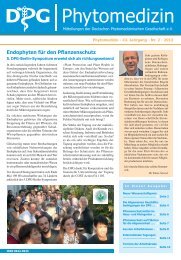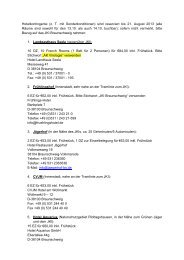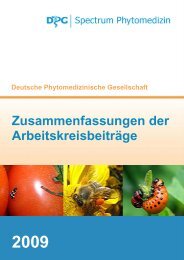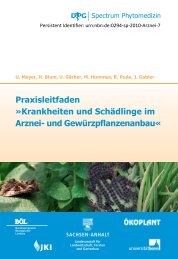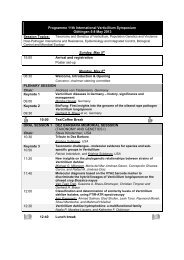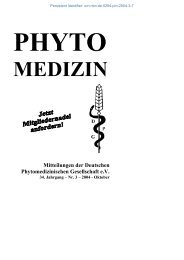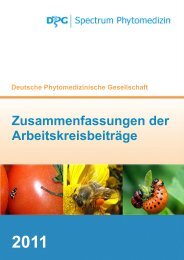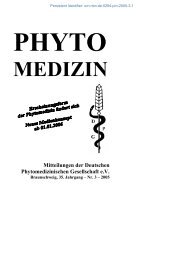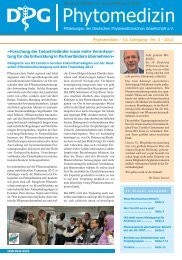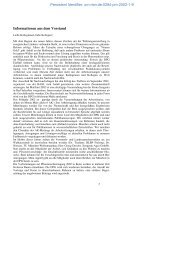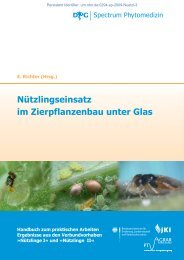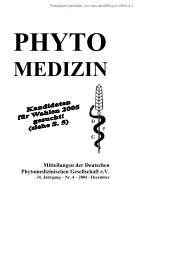fourth joint meeting of dutch and german
fourth joint meeting of dutch and german
fourth joint meeting of dutch and german
You also want an ePaper? Increase the reach of your titles
YUMPU automatically turns print PDFs into web optimized ePapers that Google loves.
fraction <strong>of</strong> intact nuclei. Similarly, BV1 protein, a movement protein encoded by AbMV B was<br />
mainly accumulated in the fraction <strong>of</strong> broken nuclei, as detected by SDS-PAGE <strong>and</strong> western<br />
blotting, whereas the coat protein (AV1) was found in all nuclear fractions. It seems that nuclei<br />
instabilities increased upon viral replication <strong>and</strong> transport, but not during packaging <strong>of</strong> DNA into<br />
virions. These findings are important prerequisites to set up an in vitro system for run-<strong>of</strong>f replication<br />
studies.<br />
The nucleoprotein gene <strong>of</strong> Tomato spotted wilt virus as a tag protein fusion for easy<br />
purification <strong>and</strong> enhanced production <strong>of</strong> recombinant protein in plants<br />
C Lacorte 1,2 , D Lohuis 1 , R Goldbach 1 <strong>and</strong> M Prins 1<br />
1<br />
Laboratory <strong>of</strong> Virology, Wageningen University, Binnenhaven 11, 6709 PD, Wageningen, <strong>and</strong><br />
2<br />
EMBRAPA-Recursos Genéticos e Biotecnologia, Brasília, DF.<br />
E-mail: cristiano.lacorte@wur.nl<br />
Upon infection, Tomato spotted wilt virus (TSWV) forms ribonucleoprotein particles (RNPs) that<br />
consist <strong>of</strong> nucleoprotein (N) <strong>and</strong> viral RNA. These aggregates result from the homopolimerization<br />
<strong>of</strong> the N protein, <strong>and</strong> are highly stable in plant cells. These properties feature the N protein as a<br />
potentially useful novel plant-based protein fusion system. To evaluate this potential, we tested<br />
whether the N protein <strong>and</strong> N protein fusions could be efficiently produced in plants <strong>and</strong> purified as<br />
aggregates, outside the context <strong>of</strong> viral infection. To this end the N gene was fused to GFP (Green<br />
fluorescent protein), either at the amino or carboxy terminus, in a binary vector or in a Potato virus<br />
X (PVX) vector. Nicotiana benthamiana leaves were infiltrated by Agrobacterium tumefaciens<br />
transient assay (ATTA) or inoculated with a PVX viral vector. For both expression methods N <strong>and</strong><br />
N-GFP fusion could be detected by Western blot using antisera against N or GFP. Infiltrated leaves<br />
<strong>and</strong> infected plants expressing N-GFP fusions showed intense fluorescence under UV light. For<br />
purification, a st<strong>and</strong>ard method used for viral RNPs was used, consisting <strong>of</strong> two low speed<br />
centrifugation steps <strong>and</strong> one ultracentrifugation on a sucrose cushion. The presence <strong>of</strong> N <strong>and</strong> N-<br />
GFP fusions after this purification was confirmed by Western blot. Purified N-GFP retained its<br />
fluorescence, indicating no major changes in protein structure due to the (mild) purification process.<br />
These results show that the homopolimerization properties <strong>of</strong> the N protein can be used as a fast<br />
<strong>and</strong> simple way to purify large amount <strong>of</strong> proteins from plants. In further research, the capacity <strong>of</strong><br />
TSWV N will be tested as an epitope presentation system. As TSWV N assembles in pseudo-RNP<br />
structures, it might not face some <strong>of</strong> the size <strong>and</strong> conformation constrains <strong>of</strong> some <strong>of</strong> the currently<br />
available epitope presentation systems.<br />
Changes in the spectrum <strong>of</strong> PVY strain groups <strong>and</strong> their involvement in potato <strong>and</strong> tobacco<br />
diseases<br />
K Lindner 1 <strong>and</strong> N Billenkamp 2<br />
1 Federal Research Centre for Agriculture <strong>and</strong> Forestry, Institute for Plant Virology, Microbiology<br />
<strong>and</strong> Biosafety, Braunschweig <strong>and</strong> 2 L<strong>and</strong>esanstalt für Pflanzenbau Forchheim, Rheinstetten<br />
E-mail: k.lindner@bba.de<br />
Potato virus Y (PVY) is a member <strong>of</strong> the Potyviridae, a large <strong>and</strong> economically important plant virus<br />
family. The three major strain groups <strong>of</strong> PVY are PVY O , PVY C <strong>and</strong> PVY N , differentiated by<br />
symptoms on tobacco <strong>and</strong> potato plants. In addition, there have been two new subgroups <strong>of</strong> PVY N ,<br />
PVY NTN <strong>and</strong> PVY N W, first described in 1984 <strong>and</strong> 1991, respectively. PVY NTN causes necrotic rings<br />
on the surface <strong>of</strong> potato tubers whereas PVY N W resembles PVY N in symptomatology on tobacco<br />
but has serologically been assigned to strain group PVY O . During the last 10 years these new<br />
PVY N subgroups have become the prevalent PVY strains in Germany. While in 1997 potatoes were<br />
predominantly infected by PVY O (survey in Bavaria), six years later most <strong>of</strong> the PVY infections<br />
were caused by PVY N (survey in Germany). More than 90 % <strong>of</strong> PVY N infections in 2003 belonged<br />
to the PVY NTN subgroup. Results <strong>of</strong> bioassays also indicated that there has probably been a sharp<br />
increase in the proportion <strong>of</strong> PVY N W among PVY O infections, although this could not have been<br />
confirmed by molecular-genetic assessments, yet. The increasing importance <strong>of</strong> the subgroups<br />
NTN <strong>and</strong> NW may be a reason for the decline <strong>of</strong> PVY resistance <strong>of</strong> potato varieties since the time<br />
period <strong>of</strong> 1988-93. Based on a susceptibility rating system ranging from grade 1 (no susceptibility)<br />
to 9 (very high susceptibility), PVY susceptibility increased on average by two grades per variety<br />
during the last 11 to 16 years. Although field resistance <strong>of</strong> some potato varieties against PVY has<br />
also been overcome during recent years, extreme resistance to PVY has been durable so far. On<br />
26



